Top Personal Branding Strategies for 2024 to Elevate Your Image
Want to create a strong personal brand? Discover effective personal branding strategies to make you stand out in 2024. This guide will cover how to define your unique identity, engage your audience, and maintain a consistent message.
Key Takeaways
- Identify and articulate your unique value proposition (UVP) to differentiate yourself and resonate with your target audience.
- Maintain a consistent and authentic brand message across all platforms to build trust and familiarity.
- Leverage high-quality content, public speaking, and social media to establish thought leadership and extend your professional reach.
Understanding Personal Branding
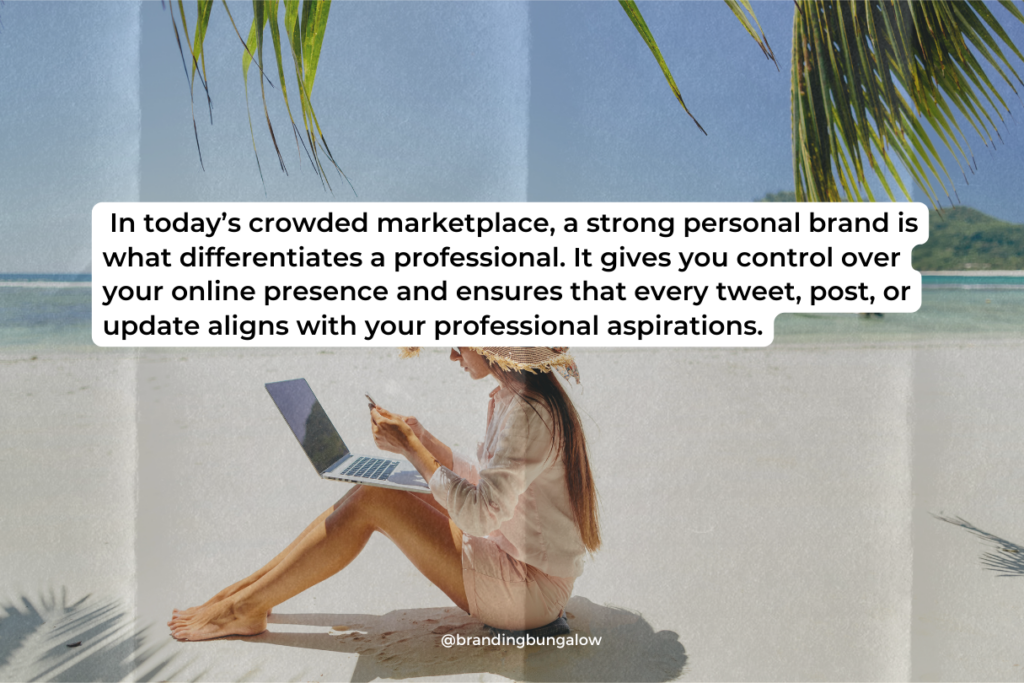
Personal branding is akin to telling a story, where the protagonist is you, and the narrative is the unique amalgamation of your skills, experiences, and values. Imagine sculpting your digital persona in such a compelling way that it leaves a lasting impression, ensuring that you are not just seen but remembered. It’s about creating a personal brand that helps you stand out in the professional world, a world brimming with talent and ambition.
This distinctive online identity is not crafted overnight. It requires a well-thought-out personal branding strategy, one that increases your visibility, recognition, and credibility. By adopting personal branding, you’re not just enhancing your individuality. You’re also earning the trust of your audience and extending your professional reach beyond your immediate network. Ultimately, you’re building strong personal brands.
But why is personal branding so pivotal? In today’s crowded marketplace, a strong personal brand is what differentiates a professional from a plethora of others. It gives you control over your online presence and ensures that every tweet, post, or update aligns with your professional aspirations. This control is a superpower in the digital age, where your personal brand helps to make it your greatest asset.
Identifying Your Unique Value Proposition
Embarking on the personal branding journey begins with identifying your unique value proposition (UVP). This is the core of your brand, the essence of what makes you, you. It’s not just about listing your skills or achievements. Rather, it’s about crafting a narrative that showcases your authentic self, including your passions, values, and beliefs. It’s about understanding the meaningful impact your product or service has on your customers, rather than just its features.
Your UVP is the compass that guides your mission, influencing the content you create and shaping the message you send out into the world. It is what differentiates you from the competition, making you uniquely appealing to your target audience. Remember, your UVP is not static; it evolves as you grow professionally and personally, reflecting a dynamic personal brand that resonates with others.
Seek feedback, listen to testimonials, and engage in conversations with your audience. These interactions can validate and refine your value proposition, making it more compelling and relatable. Your UVP is your brand’s heartbeat, pulsating through every aspect of your personal branding strategy.
Defining Your Target Audience
Once you’ve honed your UVP, the next step is to define your target audience. This is about getting crystal clear on who you are speaking to and what they need. By identifying a specific target audience, you create a personal brand that resonates with ideal clients and provides solutions to the challenges they face. It’s about segmenting your audience and tailoring your communication to build a more profound connection with prospective clients.
Creating audience personas is like sketching characters in a novel. These personas give life to your target audience, helping you craft content that speaks directly to their needs. This personalized approach is not a one-time effort; it’s a continuous process of testing, refining, and adapting based on feedback and performance metrics to ensure ongoing relevance and effectiveness.
Defining your target audience does more than just guide your content; it shapes your entire personal branding strategy. It determines the language you use, the platforms you choose, and the stories you tell. It’s about creating a personal branding strategy that doesn’t just speak to an audience but speaks to your audience.
Crafting a Consistent Brand Message
A strong personal brand thrives on consistency. It’s about crafting a brand message that is the same across all platforms, whether it’s your website, social media profiles, or any other form of communication. Consistency breeds familiarity, and familiarity breeds trust. Your goal is to build a consistent image and voice that instantly conjures your personal brand in the minds of your audience.
This uniformity in branding extends beyond words to the visual elements that represent you. Your logo, color palette, and typography should not only be cohesive but also reflect the heart of your brand story. Develop a style guide to maintain this visual and verbal consistency across all channels. This guide acts as a blueprint for your brand, ensuring that every piece of content you create aligns with your core values and messaging.
But consistency isn’t just about what you say; it’s also about how often you say it. Creating a content calendar helps you maintain a steady flow of communication with your audience. Consistency in your brand message means being present in your audience’s lives, providing value on a regular basis, and reinforcing your brand’s presence in their minds.
Building an Optimized Personal Website
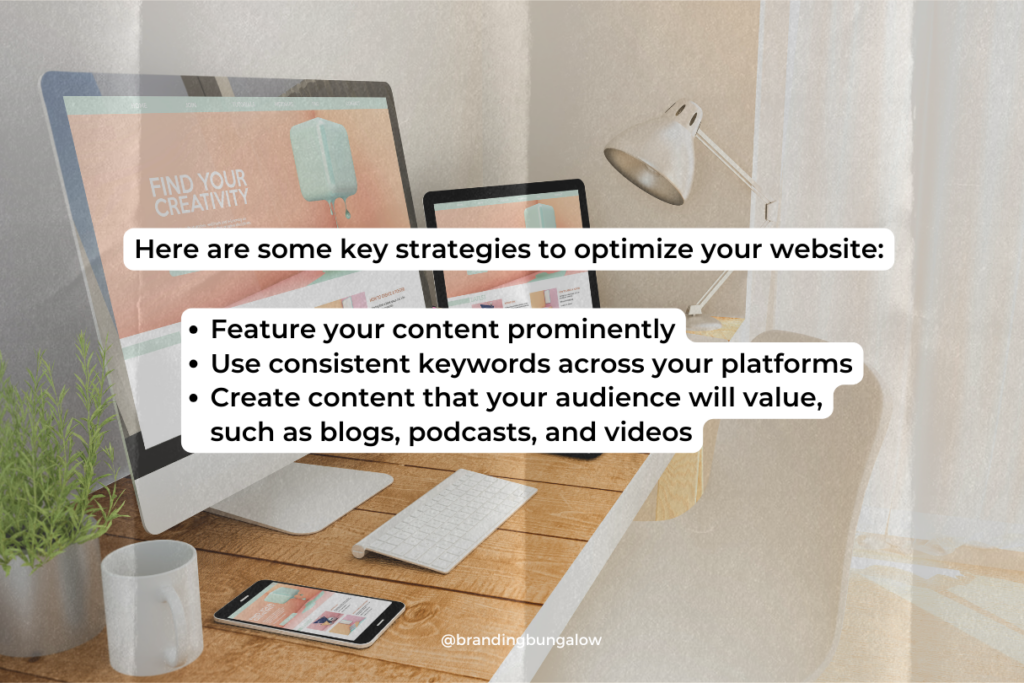
In the landscape of personal branding, your website is your digital storefront, and optimizing it is crucial for making a lasting impression. An optimized personal website should include:
- Well-structured design
- Clear messaging
- Strategic SEO practices
- Essential pages like your blog, about page, contact information, and portfolio or services page
These elements will make it easy for your audience and search engines to understand what you’re about and guide visitors through your professional journey.
Conversion tools on your website are the secret weapons in turning visitors into leads and, eventually, clients. Whether it’s an online shopping page, a focused sales page, or compelling educational content, each element should be designed to convert. And remember, the goal is not just to attract visitors but to retain them, so focus on building an email list to nurture your followers independently from other platforms.
SEO is not just a buzzword; it’s a fundamental component of your personal website. Here are some key strategies to optimize your website:
- Feature your content prominently
- Use consistent keywords across your platforms
- Create content that your audience will value, such as blogs, podcasts, and videos
An optimized website is more than just a collection of pages; it’s a hub that represents your personal brand, offers online courses, and serves as the foundation for your online presence.
Leveraging Social Media Channels
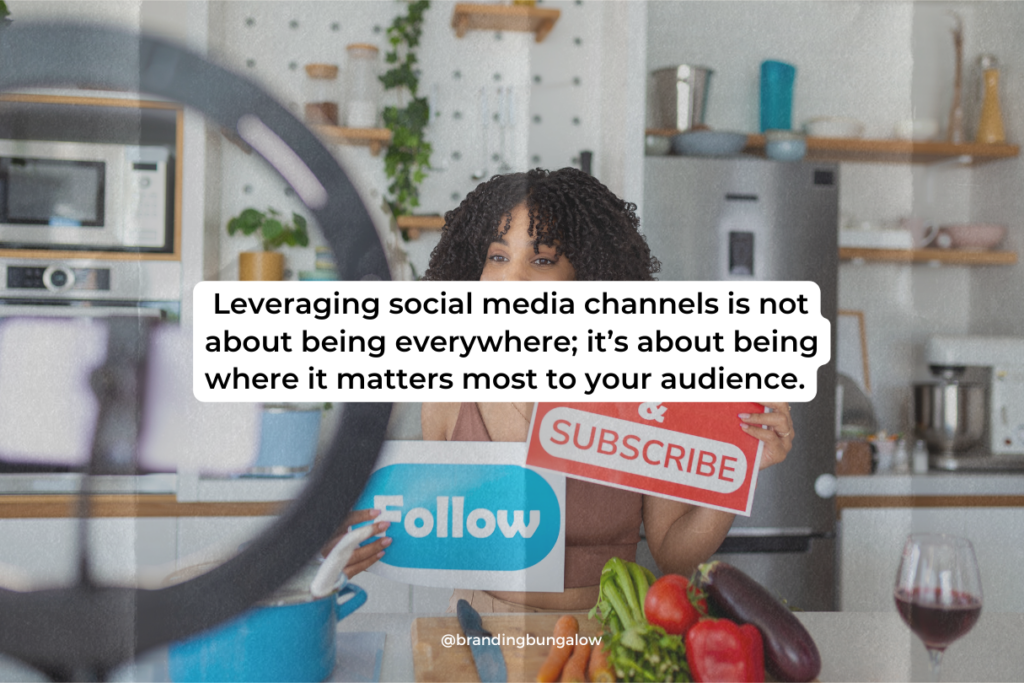
Social media is the megaphone for your personal brand, amplifying your voice across the digital landscape. Leveraging social media channels is not about being everywhere; it’s about being where it matters most to your audience. With a strategic approach, social media can significantly enhance your personal brand’s reach and visibility. It provides a platform for engaging with your audience and sharing content that reflects your values and expertise.
Optimizing your social media profiles ensures that your personal brand is consistently presented across different platforms. Automation tools like Sprout and Hootsuite can help manage your social media tasks and provide valuable insights into what content resonates with your audience. But remember, automation does not replace authenticity; it’s essential to engage personally with your audience to build a genuine connection.
Additionally, social media offers opportunities for networking and collaboration that can extend your personal brand’s influence. By engaging with influential people in your industry, you can establish your presence and open doors to new opportunities. Social media is a dynamic tool in your personal branding arsenal, one that can elevate your profile and connect you with a broader audience.
Creating High-Quality Content
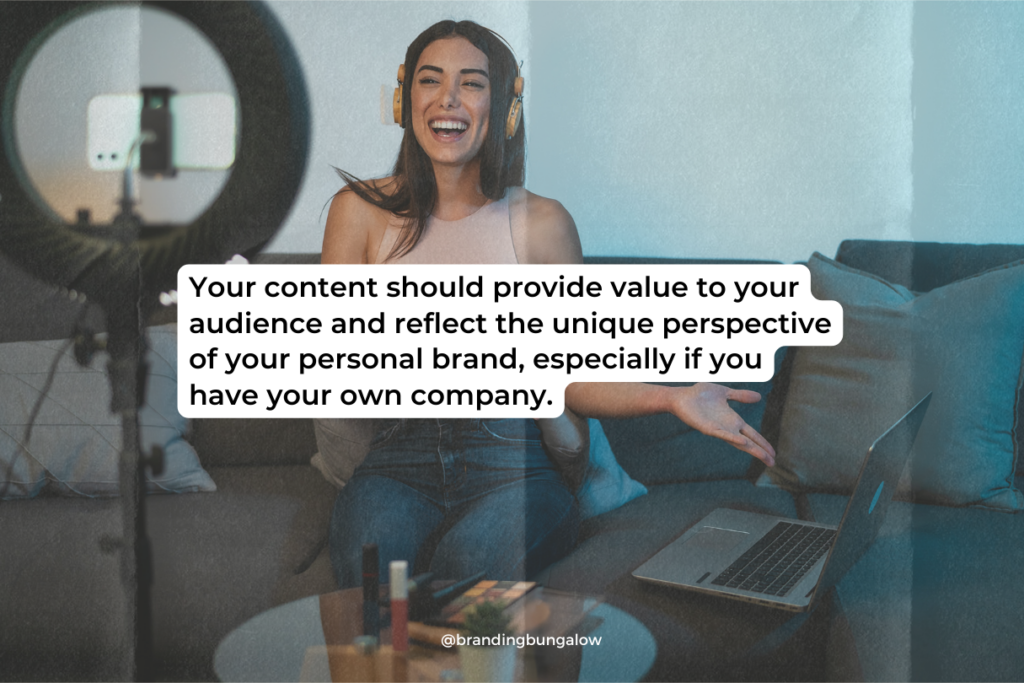
Content is king, and in the realm of personal branding, it’s the currency that builds trust, loyalty, and authority. Creating high-quality content that aligns with your personal brand and showcases your expertise is essential. Whether it’s through:
- blog posts
- podcasts
- videos
- infographics
Your content should provide value to your audience and reflect the unique perspective of your personal brand, especially if you have your own company.
The journey to thought leadership is paved with content that not only informs but also engages. Podcast appearances and live-stream interviews can bolster your speaking skills and enhance your brand visibility. Utilize tools like Google’s Keyword Planner and BuzzSumo to research keywords and discover popular topics that resonate with your audience.
Collaborating with other content creators can broaden your reach and introduce your personal brand to new audiences. Remember to invest continuously in your skills and knowledge, staying updated on industry trends to ensure that your content remains relevant and impactful. High-quality content is a reflection of your expertise and a testament to your commitment to your personal brand.
Engaging in Public Speaking and Networking
The power of the spoken word in personal branding cannot be understated. Public speaking is a direct conduit to your audience, offering a platform to showcase your expertise and establish trust. Engaging in speaking engagements allows you to convey your personal brand’s message in a more human and authentic way. It’s about starting the ‘know, like, and trust’ journey with your audience in a setting that fosters immediate connection.
Public speaking enables you to reach diverse audiences, from niche groups to broader assemblies, tailoring your message to resonate with each. To further establish your credibility, consider creating a dedicated speaker page on your website that highlights your topics, images, and videos from previous engagements. This not only showcases your experience but also serves as an invitation for future speaking opportunities.
Networking is the sibling of public speaking in the personal branding family. It’s about building relationships, sharing insights, and creating a web of connections that can support and enhance your brand. Joining social groups on platforms like Facebook, LinkedIn, or Reddit can position you as an authority and connect you with like-minded professionals.
Public speaking and networking are powerful strategies that, when combined, can substantially elevate your personal brand’s visibility and impact, contributing to business growth.
Showcasing Thought Leadership
Thought leadership is the crown jewel of a robust personal brand. It’s about positioning yourself as an expert in your field and becoming the go-to source for insights and solutions. Identifying your area of expertise is the first step in creating content that establishes you as a thought leader. Webinars, podcasts, and speaking opportunities are not just platforms to share your knowledge but are also avenues to deepen your connection with your audience.
Building relationships with influencers and other thought leaders can exponentially enhance your personal brand. It’s about collaborating to amplify visibility and credibility, creating a synergy that benefits all parties involved. Engage with your audience through social media and other channels to reinforce your thought leadership and encourage ongoing dialogue.
Thought leadership is not just about sharing what you know; it’s about contributing to the conversation in a way that drives the industry forward. It’s about sharing ideas that provoke thought, challenge the status quo, and inspire innovation. When you showcase thought leadership, you’re not just building a personal brand; you’re shaping the future of your industry.
Utilizing Personal Branding Examples
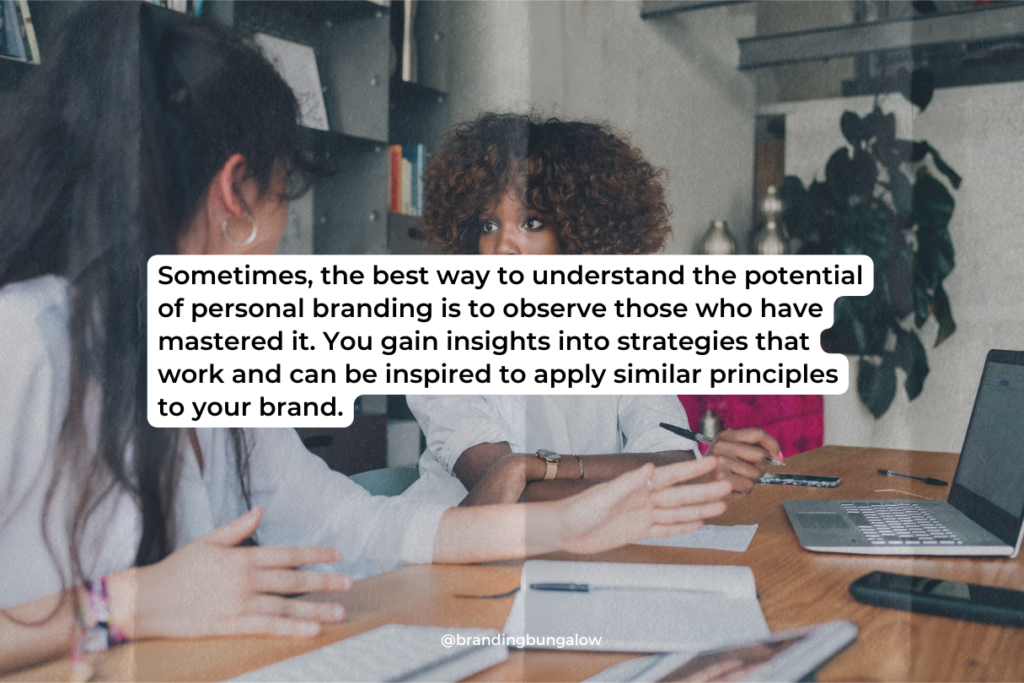
Sometimes, the best way to understand the potential of personal branding is to observe those who have mastered it. Take CyreneQ, for example, who has cultivated a successful brand on Snapchat using a unique mascot, Ele, to create a consistent and memorable identity. By examining personal branding examples like this, you gain insights into strategies that work and can be inspired to apply similar principles to your brand.
Learning from the successes of others can provide a roadmap for your personal branding journey, and understanding their strategies is half the battle.
Developing Your Personal Story
Your personal story is the emotional heart of your personal brand. It’s the narrative that defines who you are, what you stand for, and the path that has led you to where you are today. Your background, experiences, achievements, values, and goals all contribute to a story that is uniquely yours. By sharing this story in a way that balances authenticity with aspiration, you create a narrative that resonates with your audience and encourages them to engage with your brand.
Storytelling is an art, and utilizing techniques such as personal anecdotes, customer success stories, or industry statistics can make your personal story compelling and memorable. Add a personal touch by sharing your journey in authentic language, and use your personal brand story to build a connection that extends beyond mere transactions. Your About page is the perfect canvas to paint your story, answering the why, who, and how of your professional life in a way that captivates and connects.
Developing your personal story is not just about looking back; it’s about charting a path forward. It’s a tool that builds trust, establishes credibility, and engages your audience in a meaningful way. Your personal story is the thread that weaves through every aspect of your personal branding strategy, binding it together into a cohesive and influential narrative.
Maintaining Consistency and Authenticity
The twin pillars of a successful personal brand are consistency and authenticity. Consistency across platforms builds recognition and trust, ensuring that your audience knows what to expect from your brand. From your profile picture to your bio and key achievements, every element should reflect a cohesive narrative that is unmistakably you. Updating all profiles simultaneously when changes occur in your professional life is also crucial for maintaining consistency.
Authenticity is the soul of your brand, the quality that endears you to your audience and sets you apart from others. It’s about using a uniform tone and style in communication that is true to your personal identity, which is essentially your brand voice. Oprah Winfrey is a prime example of someone who has built a powerful personal brand by defining her voice and maintaining consistency in her messaging. And remember, building a successful brand often involves trial and error, so embrace failures as opportunities to learn and grow.
Consistency and authenticity are not endpoints; they are practices that you must engage with on a daily basis. They are the standards by which your personal brand is judged, and they are what will ultimately define your success in the eyes of your audience. Maintain these principles, and your personal brand will flourish.
Measuring Your Personal Branding Success
Measuring the success of your personal brand is as important as the strategies you implement. It’s about setting SMART goals and defining the metrics that will track your progress towards achieving them. Conduct a thorough audit of your online presence using tools like Google Alerts or Mention to understand how your brand is perceived and where you can improve.
Engagement metrics, branded queries, and site mentions offer a quantitative look at your brand’s impact. These insights can help you gauge the success of your thought leadership strategy and adjust your approach for better results. Additionally, comparing yourself with others using tools like Google Trends can benchmark your progress and uncover new opportunities for growth.
The process of measuring success is continuous and should involve experimentation and iteration. A/B testing different strategies or messages can help you fine-tune your personal brand for optimal outcomes. By regularly reviewing and adjusting your approach, you can ensure your personal branding efforts are effective and moving you towards your desired goals.
Summary
In conclusion, personal branding in 2024 is a multifaceted endeavor that demands clarity of purpose, authenticity, and consistency. From understanding the foundation of personal branding to leveraging social media and creating high-quality content, each strategy builds upon the other to elevate your professional image. Engaging in public speaking, networking, and showcasing thought leadership are powerful ways to connect with your audience. Remember to utilize personal branding examples, develop your personal story, and measure your success to continuously refine your brand. Embrace these strategies, and watch your personal brand soar to new heights.
Frequently Asked Questions
How can I define my personal brand’s unique value proposition?
Define your unique value proposition by identifying your authentic skills, strengths, passions, values, and beliefs. You’ll also need to understand the impact of your product or service on customers. Craft a compelling narrative that sets you apart from your competitors by drawing from your personal and professional experiences.
What are some effective ways to measure my personal branding success?
To measure your personal branding success, set SMART goals and use tools like Google Alerts and BrandYourself to audit your online presence. Track engagement metrics, monitor branded queries, and compare your brand’s reach with others in your industry to gauge success, and iterate your strategies to optimize your personal branding efforts.
How important is consistency in personal branding?
Consistency is crucial for building trust and recognition with your audience. It involves maintaining a uniform message, voice, image, and tone across all platforms. Consistency helps your audience quickly associate your brand with specific values and characteristics. Doing so is essential for a memorable and authentic personal brand.
Can you give an example of a successful personal brand on social media?
Absolutely! CyreneQ is a fantastic example of a successful personal brand on social media, particularly on Snapchat. Her use of a consistent mascot, Ele, creates a memorable identity that resonates with her audience and can provide valuable insights for your own branding efforts.
What role does storytelling play in developing my personal brand?
Storytelling is crucial in developing your personal brand. It allows you to share your experiences and values in a way that resonates with others, helping to build trust and credibility. It engages your audience and makes your personal brand more compelling and memorable.
Recent Blog Entries
Discounts to Dubsado CRM, Helcim Payment Processing and...
Brand audits can save your business' sinking marketing ship.
What's happening to Coke and what you can learn from it.
Shop Products
Create a personalize brand board by taking elements from our 3 signature brand board templates.